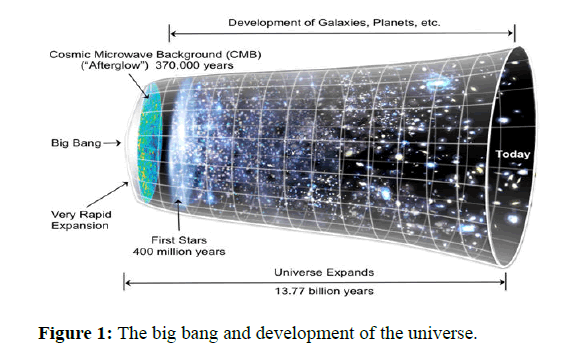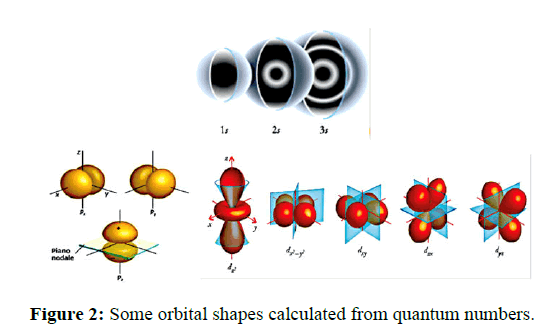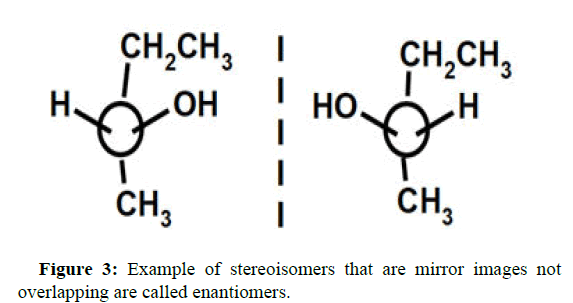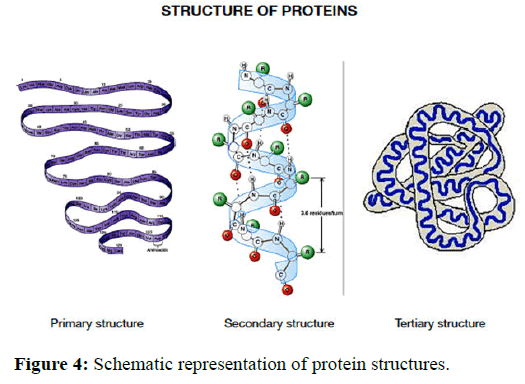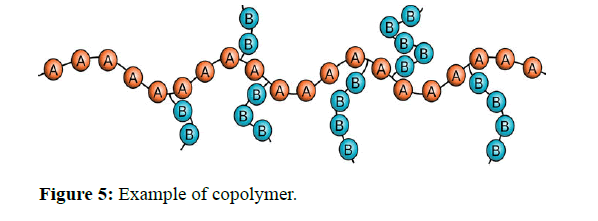Research Article, J Nucl Ene Sci Power Generat Techno Vol: -12 Issue: -3
Molecular Evolution: The Unsustainable Quantum Theory of the Origin of Matter and the Universe
Bruno Riccardi*
Individual researcher, Castelfranco di Sotto (Pisa), Via dei Lazzeri, Italy
*Corresponding Author: Bruno Riccardi
Individual researcher, Castelfranco di
Sotto (Pisa), Via dei Lazzeri, Italy; E-mail: lipotech.br@gmail.com
Received date: 31-March-2023, Manuscript No. JNPGT-23-101536;
Editor assigned date: 06-April-2023, PreQC No. JNPGT-23-101536 (PQ);
Reviewed date: 20-April-2023, QC No. JNPGT-23-101536;
Revised date: 02-May-2023, Manuscript No. JNPGT-23-101536 (R);
Published date: 30-May-2023, DOI: 10.4172/2325-9809.1000333
Citation:Riccardi B (2023) Molecular Evolution: The Unsustainable Quantum Theory of the Origin of Matter and the Universe. J Nucl Ene Sci Power Generat Technol 12:3.
Abstract
This article that examines the origin and evolution of the matter of the universe from the point of view of quantum mechanics, presents an extraordinary complexity and requires competence and solid theoretical foundations in this discipline, Nevertheless, I wanted to face it with a considerable dose of manifest unconsciousness. Although my cultural background and my studies are totally distant from the topics dealt with in the article, I would like to present those that, in my opinion, they are the logical inconsistencies inherent in the theoretical framework of quantum mechanics. If one abstracts from the rigorous language of the mathematical formulas that express and support the theoretical plant of science, there remains little to understand as regards the abstract concepts and not immediate sensory and semantic perception, which these formulas underlie. For ordinary mortals, fasting of mathematics, the only way to go to approach such a difficult matter, is to use logic to highlight the incongruous aspects and aporias contained in the epistemological-evolutionary narrative of universal matter, that quantum physics proposes. The purpose of this article is to detect such inconsistencies and propose a version accessible and I hope shared by ordinary readers, the mysterious phenomenon of becoming universal.
Keywords: Evolution matter and universe, Big bang, Quantumtheory, Molecular evolution
Introduction
Why and how did different atoms in nature form and evolve? What Is the mysterious procedure that gats rise to the evolution of the different atomic forms present in the universe and that today we represent in the periodic system of the elements? Is it chance that drives the change and variability of the corpuscular elements that make up matter, as we imagine it, and is it still chance that transforms it into all possible modes, states of aggregation and effects from these products?
The evolutionary process has so far produced the great variety of atoms that for shape and energy content express the maximum degree of freedom and have built unique molecules different and unmistakable between them. After several decades from the first hypothesis on the evolution of the universe, with the well-known theory of the big bang, still today we are discussing what were the fundamental events that led to its current state and the evolution that is still in progress. All theories of the origin of matter and the universe are based on different assumptions, which are based mainly on quantum mechanics, the central dogma of physics, their most plausible rational basis. The common denominator of these theories is the unshakeable faith in the evocative and apodictic value of the fundamental equations that make up its framework. This science is complete, absolute and perfect in its ontogeny, has no need of other hypotheses, is self-referential, and is able to answer, with the esoteric mathematical formulas above, to every question. Truth in the exact sciences is based on mathematical expressions, which the more complex and elaborate they are, the more they represent to us with absolute precision or with a statistically high approximation, the reality of natural phenomena, that otherwise we would not be able to explain [1-3].
The formulas, therefore, are the privileged shortcut, the transfer artificial, arbitrary and conventional, universally shared, which translate into an accessible language the immeasurable mystery of natural phenomena. If it is true that reality always precedes and surpasses fantasy, and therefore cannot be reached with the limited reasoning with which we are endowed, However, there remains the comforting representation of the formulas that give us a surrogate of transiently exhaustive answers to the questions that agitate our minds. Mathematical formulas have the power to transport us into a transcendent universe where everything is true and possible, where we can finally grasp the full and intimate sense of universal reality, and codify it in an organic and coherent rational system, which would otherwise escape the concreteness of our gross sensory systems. With the same quantum mechanical equations we can transform nothingness, into the prodigious event of the big-bang, from which, by virtue of bariogenesis first and then of nucleosynthesis, the simplest atoms, hydrogen and helium, originated, and from these, by spontaneous generation, the most complex cosmic atoms and systems [4,5].
The big bang theory first appeared in 1931, in an article written by physicist Georges Lemaitre, in which he stated that about 13.7 billion years ago, more or less year, after the explosion of a single particle, our universe originated. After this first fundamental event, all the others that follow are simple and well documented, described with the scientific rigor of the exact sciences, in distinct phases, as follows:
The first phase, called the great unification (or planck phase), in which matter and energy collided, and there were no distinctions between atomic, gravitational or electromagnetic forces, also because, at that time there was still no physicist to formulate the distinctions. This was followed by the Inflation’s Phase, with the process of rapid expansion lasting a hundredth of yoctosecond (yoctosecond represents 10-24 parts of a second).
Later, (when? here is missing any temporal reference) the universe began to cool from a billion billion billion degrees to "only" a billion degrees, and expanded also from the dimensional point of view, from an approximate diameter of 10 meters to about 1 million kilometers.
In this phase a very important thing happened, that is, the "initial" energy divided (by spontaneous generation?) into the four main components that still regulate the universe: Gravitational interaction, electromagnetic interaction, strong nuclear interaction and weak nuclear interaction. These definitions correspond to the forces that allow elementary particles (including particles that make up matter) to interact with each other. Subatomic particles that begin to form and combine include exotic names such as gluons, quarks and electrons, which are the building blocks that will form the basis of our atoms. What is described here is not the product of my fervent imagination, but is found in several articles [6]. Here the fascinating and imaginative story of the evolution of universal matter ends. For acting as a link between the stratospheric complexity of the universe and our neurosensory system, which must examine and describe it rationally, there is a large series of measurements that signal and witness events light years away in space and time, and barely perceptible physical quantities even with the most sophisticated measuring instruments.
Materials and Methods
It is evident that the description of the origin and evolution of the universe proposed by quantum astrophysics is an abstract and imaginary reconstruction based on subjective interpretations of indirect tests and instrumental results. How one can deduce from posthumous effects and measurements and reconstruct events that occurred billions of years before is an epistemic operation that only succeeds quantum physicists. In Archaeology and Paleontology a similar historical reconstruction of facts and cultures of the past is based on real and concrete archaeological finds collected in existing and well-defined geographical areas in the deep layer of the soil stratified for thousands of years.
Unlike quantum mechanics, these disciplines have a scientific foundation based on actual and real evidence. Although in any case there remain many obscure points in the reconstruction and interpretation of past historical eras. Inevitably, all sciences rely on logical procedures, suitably and arbitrarily codified, with the so-called scientific method, the theories with which they attempt to combine natural or experimental events observed in a convincing epistemological reconstruction. In the absence of rigorous and replicable documentary evidence, such as those referring to billions of years past, it is advisable to refrain from improbable theoretical reconstructions and bring to the foreground the original insurmountable limit of cognitive abilities that characterize us. Consequently, it is wise to adopt with respect to the infinite complexity of the universe that we would like to understand, a prudent reserve and intellectual honesty in recognizing our limitations, in order not to expose ourselves to public ridicule.
How is the big bang studied?
At this point it would be legitimate to ask "okay, but all these things how were discovered?"
In order to combine the evanescence of events not observed, but only hypothesized, and translate them into language accessible to humans, it is essential to resort to quantum theories and formulas that express them. The evidence for the Big Bang theory is basically three:
• Study of the expansion of galaxies by red shift
• Measurement of cosmic background radiation
• Abundance of light elements in the universe
Red shift: It is the Doppler effect produced by a luminous body that moves further away from us and the more its light seems to us to be red (hence the term red-shift).
Cosmic background radiation: Microwave system discovered by Arno Penzias and Robert Wilson in 1964, these are large quantities of photons that can be seen as the residue of the primordial heat of the universe. The distribution of these microwaves is slightly irregular, almost "blotchy", with relatively warmer and relatively colder areas.
Abundance of light elements: Light elements means the first three elements of the periodic table: Hydrogen, helium and lithium. The atomic nuclei of these elements, which we can observe even today in the Universe, were formed in fact in the very first minutes following the big bang: A phenomenon called primordial nucleosynthesis.
This has made it possible to hypothesize that the achievement of the complexity and plasticity of atoms has been possible thanks to the mechanism of the fusion of different atomic nuclei, a process called nucleosynthesis and subsequently, with the addition of other elementary particles, have assumed different spatial-temporal and energetic conformations (Figure 1).
Results and Discussion
The quantum interpretation of matter
To make the abstraction of quantum mechanics we are going to report two of the fundamental equations that form the supporting structure of the theoretical building.
Schroedinger’s equation:

In this equation appears the function Ψ called wave function, whose square Ψ2 corresponds to the probability density of finding the electron, based on the energy it possesses, in a certain region of the space around the nucleus. Figure 2 shows the orbital shapes derived from the equation.
The uncertainty principle of W. Heisenberg (1901-1976) which states:
• It is not possible to accurately determine the trajectory of the electrons around the nucleus.
• It is not possible to know, exactly, both the X position and the P moment of an electron.
• If you measure one of the two sizes very accurately, then you make a big mistake in the measurement of the other expressed by the following formula:
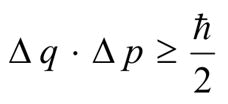
Where x and p are respectively the indeterminations in the position and momentum of a material body, ℏ said h cut, and is sometimes called Dirac constant, is the Planck constant and has a fixed value. In simple words, the smaller the Δx (that is, the more the measure of x, or position, is accurate), the larger the Δp (that is, the measure of momentum is inaccurate).
The possibility of hybridization would also allow individual atoms to form bonds with different spatial orientation and increase their ability to form different molecules with other atoms and increase their competitive advantage. By virtue of these two equations, the atoms and the molecular aggregates from these formats individually acquire unique and unmistakable properties with others. In this way they can form ever new and original macromolecular complexes and experience infinite possibilities of morpho-functional evolution. Ultimately, all quantum mechanics is based on the two fundamental equations mentioned above. In one, Heisenberg principle, it is stated that it is not possible to know the position and speed of electrons, which therefore we can only imagine them; while the Schroedinger equation expresses the probability of finding an electron on its orbit in a certain region around the nucleus [7-11].
From the foregoing we can say that quantum mechanics presents conceptual and method limits that compromise its reliability in describing the properties of matter. The first fundamental limit is represented by the measurement operation, as the same theorists recognize and admit, because the process or method of measurement introduces three independent and random variables that it is impossible to control with the rigor that science requires [12-14].
Limits of the measurement method: In fact, the measurement process introduces three independent variables that affect the whole process.
The object to be measured: Any object present in nature, in the microscopic universe and in the macroscopic universe is subject to continuous changes in position, volume, consistency, etc. So that what we see in a definite instant is different a subsequent instant.
The unit of measurement: The unit of measure is chosen and defined arbitrarily, assuming physical quantities that represent them through operating procedures, even these arbitrary (e.g. Time is calibrated on the isotope 133 of the caesium atom (Cs). (this element is assumed to be eternally immutable or rather the decay time (measured as ? ) is considered such.
The observer: The necessary presence of an observer who measures phenomena according to his own subjective evaluation introduces as many variables as there are observers. To complicate and frustrate the method is the fact that it is the same observer who chooses and defines the units of measurement, to actually perform the measure.
Starting from these premises, quantum mechanics constructs its theoretical building by means of formulas describing the relations between the quantities measured by the method described above. But his own formulas and equations are nothing more than the result of logical-operative procedures based on postulates and theorems arbitrarily introduced by scientists over the years and shared by convention. But to render fragile and evanescent all the theoretical complex that supports the metaphysical construction of quantum mechanics is the simple observation that this exact science, like all the others, it was built and conceived by an absolutely imperfect and selfreferential cognitive apparatus: The neurosensory system of which we are endowed. As long as this system guides us in our research, and devises formulas and equations that gratify us and satisfy our senses and our reasoning, to the total benefit of man and the irrepressible need for knowledge, everything will go perfectly. But the moment he claims to be infallible and imposes the dominion of scientists and of the complex apparatus that supports and nourishes them, on the rest of men, he will have failed in his mission.
From atoms to molecular evolution
We described earlier that atomic theory comes from how we imagined the building blocks of matter, or how we are represented by the sophisticated technological tools we have. We have also seen how quantum mechanics has built the theoretical framework with which it represents atoms and universal matter. Let us now make an imaginary leap of a few billion years, to arrive at the moment when the earth and the first complex molecules were formed, avoiding any theoretical speculation of how this happened because it would complicate the description of the process, which we ignore [15,16].
In biology, complex molecules, or macromolecules, are distinguished by their structural and functional activity. This distinction is actually only useful from the didactic point of view, since in biological systems the macromolecules of the same class often absolve both activities. For example, carbohydrates (sugars) perform both functional energy activity (starch, glycogen) and structural function (cell wall of plants and bacteria), lipids serve as energy reserves (reserve fat) or as fundamental structural elements of cell membranes. Basically, the macromolecules are all formed by the same chemical elements differently organized, which are the following Table 1.
| Element | Symbol atomico | % in body mass |
|---|---|---|
| Oxygen | O | 65.0% |
| Carbon | C | 18.5% |
| Hydrogen | H | 9.5% |
| Nitrogen | N | 3.3% |
| Calcium | Ca | 1.5% |
| Phosphorus | P | 1.0% |
| Potassium | K | 0.4% |
| Sulfur | S | 0.30% |
| Sodium | Na | 0.20% |
| Chlorine | Cl | 0.20% |
| Magnesium | Mg | 0.10% |
| lodio | I | 0.10% |
| Ferrus | Fe | 0.10% |
Table 1: Naturally occurring chemical elements.
In summary, what characterize a substance are its structural conformation and the associated energy content, which manifests itself at all levels, atomic and macromolecular, in the form of electromagnetic activity in its various declinations.
The principle of symmetry as an evolutionary factor: A particular aspect that is striking when examining molecular structures is the asymmetry that characterizes them. In nature all functionally active molecules are endowed with this property that is repeated throughout the cosmos, and has reached its maximum expression in biological systems. Normally, all functionally active biological molecules belong to a single category among the possible mirror forms, called enantiomers D and L, which is that of the only enantiomer L, or of the only enantiomer D (Figure 3) [16-19].
In nature, important molecules, such as sugars, have more chiral centers and therefore exist in the form of more optical isomers. Only the D-series sugars are important for humans, just as only the L-amino acids enter the 'construction' of proteins. Enzymes, that are biological catalysts, are stereospecific and recognize only the optical isomers of one type. This very interesting and difficult property has always attracted the attention of researchers who have not been able to explain this phenomenon. The possible explanation could be that the adoption of a single form among the possible enantiomers has the advantage of giving an unmistakable and recognizable unique response in all biological systems, when steric coupling occurs in metabolic processes. Having a unique shape for each molecule that is represented by its "molecular imprinting" or specific threedimensional molecular footprint, offers biological systems the guarantee of an orderly and rational functioning effectively avoiding unnecessary and unproductive chaos and confusion and this is what we observe by examining the fundamental elementary molecules present in living systems, we find only one class of amino acids, of carbohydrates, and in the components of lipids, glycerides and fatty acids, as well as in the information molecules, neurotransmitters, hormones and so on.
This is what happens in molecules that express functional activity, while the complex macromolecules that have structural function, such as polymers, respond to a different morphogenetic logic. In this case, the essential role that comes into play is the three-dimensional conformation that can take infinite forms (primary structure, secondary, tertiary and quaternary structure) according to the sequence of constituent monomers. In this way the level of complexity and uniqueness that molecules can reach is infinitely large and is what we observe in the immeasurable variety of living forms.
Therefore, if we want to hypothesize the fundamental Rules that guide the matter, we can summarize in:
• Uniqueness of the constituent elements, atoms, molecules, macromolecules, each of which has a unique and unmistakable three-dimensional structure that is the mold or molecular footprint that distinguishes them.
• Consequently, each one has a unique and unmistakable energetic, electromagnetic and polar content detectable by appropriate instrumental methods.
• As the level of structural complexity increases, the possibility of wrong functional coupling between different entities is reduced, which takes place instead on the basis of steric affinities and complementary energy content, examples: Substrate enzyme, receptor effector molecule and so on.
These properties have guided and guide the molecular evolution and that of the living towards different and constantly evolving forms and expressions, while those currently existing have reached a dynamic equilibrium with the external environment. The environment is another powerful morphogenetic factor that regulates and conditions the evolution of molecules by means of natural selection, which is achieved with recognition by specific complementary coupling between sterically compatible molecules in a given ecosystem.
This system is particularly developed in cellular receptors, enzymatic reactions, immune mechanisms, etc. The final effect produced by the specific recognition system is a conformational modification of one or both participating macromolecules and allows a series of cascade reactions that produces the effective result. This is what normally happens in metabolism. Often to trigger the conformational modifications, are some ions that with the contact with target molecules introduce the steric transformations necessary to activate the path of chain reactions. The high degree of complexity and structural diversity that present the macromolecules, gives us an indication of the morphogenetic significance, which underlies their selection. We have already mentioned the conformational structural identity of macromolecules that defines the molecular footprint characteristic of each one. Such a characteristic allows a possible steric coupling only between complementary molecules or by conformational contact or by electrostatic interaction between atoms arranged in the correct sequence (weak van der walls forces, hydrogen bonds, dipolar bonds, etc.).
From macromolecules to early life
A fundamental stage that led to the first forms of life on our primordial planet was the ability of macromolecules to organize themselves in systems capable of communicating, modifying the conformational state and transferring information from one macromolecule to another. Today we know that such a task is fulfilled by the DNA>RNA>Protein system, encoded in the central dogma of biology. In the primordial magma existing on our planet billions of years ago, complex macromolecules with replicative capacity were organized and able to induce structural modifications in other macromolecules. These systems are called Autocatalytic. An equivalent system is found today in proteins that function as enzymes.
In fact, enzymes are capable of modifying size, conformation, and metabolic function in other similar or different structures. In performing this function, which takes place exclusively in solution, require only special conditions of pH and temperature and concentration, compatible with the stability of the system. If then such an activity takes place with coordinated sequential mechanisms it is possible to obtain a primordial system of elementary metabolism. Today we know countless metabolic processes that work by adopting the same sequential systems. Another role that proteins can play is the ability to replicate [20-26].
This peculiar activity, which we considered exclusive to DNA, was also found in protein structures called prions. They have the ability to adopt at least one conformation that can replicate. This allows them to serve as epigenetic elements that can be transmitted through mitosis and meiosis. In some circumstances, self-replication may feed or cause disease (mad cow disease, amyloidosis, Alzheimer’s disease, etc.). The common denominator of the autocatalytic capabilities of macromolecules and proteins in particular, lies in the information and energy content that express molecular structures with their primary composition, secondary conformation and are carriers of the infinite expressive possibilities that life manifests us. The informationalenergy content linked to polymer structures is the result of the monomeric components that compose them. When the sequence of monomers changes, there is a different primary structure, which involves a different three-dimensional folding (secondary structure), etc. (Figures 4 and 5) [27,28].
Conclusion
From all this, the question of the questions arises, and it is as follows: Are we really able to know any aspect of the universe around us? Is our cognitive structure suitable to grasp all aspects of the phenomena we observe in nature in their intimate essence?
The answer that comes naturally to give is NO, we are not able to fully know in the innermost details the real structure of matter that forms the universe and what is contained in it. In reality there is a more considered answer to the initial question and it is that we are able to know the manifestations of the universe compatibly with the cognitive structures that we are equipped with here and now. We are talking about the sensory and neuronal system that we have, which is not really the best possible, judging by what it has produced so far: Wars, inequalities, injustices, pollution etc. And what about the natural catastrophes that loom, with disarming cyclicality on our planet, earthquakes, floods, cyclones, tsunamis, etc., that no mathematical formula is able to predict and no technology is able to dominate?
And here a second question immediately arises: But what is the degree of knowledge that such a sensorineural system can obtain? We can simply answer this question: We do not know. Here lies the central point of all the questions that science attempts to answer. The dichotomous nature of our neurosensory apparatus on the one hand manages to create sublime works of art and extremely advanced technology, from nanotechnologies to aerospace and nuclear technology etc., while it is unable to comprehend the intimate nature of matter or universal evolution. However, he manages to sublimate with his creative ability and imagination, what he is not able to perceive and interpret with his neurosensory apparatus. So, in a nutshell,
• We have a cognitive apparatus that we do not know or know in little part;
• With this apparatus inadequate to know the infinite complexity of the universe, which moreover still appears to us in continuous evolution, we can only grasp the manifestations that we can record and interpret, but nothing more.
Even with the use of the advanced technological tools we have in order to carry out more accurate examinations, the question of realworld knowledge still remains valid, because in the end those who must interpret the results of these observations are, Once again our neurosensory apparatus. Therefore, let us not get out of this logical vicious circle. The only possibility that remains is to rely on our limited resources gnoseologiche, and build a coherent and rationally acceptable theoretical system that these allow us. Transcending this reality conditioned by our material essence is not possible, and I would say not even desirable.
Conflict of Interest
The author report no conflicts of interest in this work.
References
- Hawking S (2009) The origin of the universe. Pontificia Academia Scientiarum, Vatican city, pp. 57-77.
- Macek WM (2022) On the origin of the universe: Chaos or Cosmos? In 14th Chaotic Modeling and Simulation International Conference, Cham: Springer International Publishing, New York, pp. 311-326.
- Adhikari KR (2011) The question on origin of the universe and big bang. Himal Phy 2: 67-70.
- Earle S (2019) Origin of earth and the solar system. Physical Geology, United States.
- Kumar V (2022) Origin of the universe: 7 different theories. Rank Red, United States.
- Siegel E (2017) Science uncovers the origin of the first light in the universe. Forbes, United States.
- Scale M (2009) Interpretations of quantum mechanics. Wikipedia the free encyclopedia.
- Chen ZB (2014) The information-complete quantum theory. Quant Eng 12: 2022.
- Kober M (2019) Copenhagen interpretation of quantum mechanics. Stanford Encyclopedia of Philosophy, United States.
- Drummond B (2019) Understanding quantum mechanics: A review and synthesis in precise language. Open Phy 17: 390-437.
- Einstein A, Podolsky B, Rosen N (1935) Can quantum-mechanical description of physical reality be considered complete? Phy Rev 47: 777.
- Bell JS (1989) Against measurement. Phys World 3: 33-40.
- Aerts D, de Bianchi MS (2014) The extended Bloch representation of quantum mechanics and the hidden-measurement solution to the measurement problem. Anna Phys 351: 975-1025.
- Wigner EP (1963) The problem of measurement. Am J Phys 31: 6-15.
[Crossref]
- Trefil J, Morowitz HJ, Smith E (2009) The origin of life, biology chemistry evolution. 97: 206.
- Das A (2019) The origin of life on earth-viruses and microbes. Acta Sci Microbiol 2: 22-28.
- Ageno M (1982) Simmetria in biologia. Enciclopedia del Novecento, US.
- Symmetry definition (2023) Biology on Line, United States.
- Mahe K, MacKenzie K, Ider D, Massaro A, Hamed O, et al. (2021) Directional bilateral asymmetry in fish otolith: A potential tool to evaluate stock boundaries? Symmetry 13: 987.
- Hermann W (1975) La simmetria. 1st edition, Feltrinelli, Milano.
- Harvey ZH, Chen Y, Jarosz DF (2018) Protein-based inheritance: Epigenetics beyond the chromosome. Mol Cell 69: 195-202.
[Crossref] [Google Scholar] [PubMed]
- Chiesa G, Kiriakov S, Khalil AS (2020) Protein assembly systems in natural and synthetic biology. BMC Biol 18: 1-18.
[Crossref] [Google Scholar] [PubMed]
- Ameta S, Matsubara YJ, Chakraborty N, Krishna S, Thutupalli S (2021) Self-reproduction and Darwinian evolution in autocatalytic chemical reaction systems. Life 11: 308.
[Crossref] [Google Scholar] [PubMed]
- Sigurdson CJ, Bartz JC, Glatzel M (2019) Cellular and molecular mechanisms of prion disease. Ann Rev Pathol Mech Dis 14: 497-516.
[Crossref] [Google Scholar] [PubMed]
- Zhou Z, Xiao G (2013) Conformational conversion of prion protein in prion diseases. Acta Biochim Biophys Sin 45: 465-476.
[Crossref] [Google Scholar] [PubMed]
- Kraus A, Hoyt F, Schwartz CL, Hansen B, Hughson AG, et al. (2021) Structure of an infectious mammalian prion. BioRxiv, pp. 1-31.
- Das AS, Zou WQ (2016) Prions: Beyond a single protein. Clin Microbiol Rev 29: 633-658.
[Crossref] [Google Scholar] [PubMed]
- Luise D, Lezioni F (2010) La filosofia inglese del seicento, Sui limiti della conoscenza umana.
 Spanish
Spanish  Chinese
Chinese  Russian
Russian  German
German  French
French  Japanese
Japanese  Portuguese
Portuguese  Hindi
Hindi 